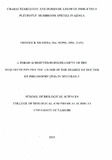| dc.description.abstract | Mushrooms are traditionally consumed In Western, Nyanza and Coast regions In Kenya.
They have been utilized by local communities for a long time and form an integral part of a
long standing cultural and traditional practice. However, collection of wild mushrooms has
been decreasing with time due to changes in agricultural practices and degradation of
indigenous forests. Until now, there has been no report on the diversity, distribution and
abundance of indigenous Pleurotus mushrooms in Kenya. On the other hand, mushroom
growers in Kenya are constantly searching for new strains of Pleurotus mushroom. The strain
with a high ability to colonize substrate and fruit quickly is the most preferred. Currently all
cultures of mushrooms multiplied in Kenya are imported from Belgium, China, France, Japan
and South Africa. This study was formulated to characterize and develop protocols to
domesticate indigenous Pleurotus mushrooms. The project sought to determine the diversity,
distribution and abundance of indigenous species of Pleurotus mushrooms from the
Kakamega and Arabuko Sokoke forests, their cultivation requirements and nutritional
composition.
Data on Pleurotus diversity and distribution patterns was obtained by opportunistic sampling.
The samples were characterized and identified using morphological and molecular markers.
Their growth and yield performance on selected locally available substrates was determined
and the elite species selected for domestication studies based on their ability to develop
basidiomata under the experimental conditions.
Elite species of Pleurotus mushroom-was analyzed to determine its proximate composition,
mineral, amino acid and vitamin contents. Crude protein, crude fat, moisture content, dry
matter, ash, crude fiber, and carbohydrate content and amino acids were determined
according to the Association of Official Analytical Chemists (AOAC, 1995 and 2006)
methods. Mineral element analyses were determined using flame technique of Atomic
Absorption Spectrophotometer (Model-Shimadzu AA-6300). Phosphorus content was
estimated by Ultra Violet spectrophotometer (Model: Spectrophotometer) Ammonium
molybdovanadate method (AOAC, 2006). Vitamins were determined using the methods
described by British standards and AOAC official methods of Analysis and protein through
the Kjeldahl method. The calorific value was determined using a calibrated Adiabatic Bomb
Calorimeter (Ika-Kalorimeter C400 Adiabatic) under controlled conditions.
The collections were grouped under five species. Four Pleurotus species were collected from
Kakamega forest while one from Arabuko Sokoke forest. Combination of morphological and
genetic markers revealed the diversity in the Pleurotus isolates. Pleurotus citrinopileatus
mushroom was the most abundant and widely distributed species in Kakamega forest. The
occurrence of Pleurotus citrinopileatus on new hosts was reported for the first time in Kenya.
Only one isolate, Pleurotus citrinopileatus developed fruiting bodies under experimental
conditions and was considered for production and nutritional analysis experiments. Bean
straw emerged as the most suitable substrate for cultivation of this mushroom. Bean straw
showed the shortest colonization period and the highest biological efficiencies and yields
with maximum yield (397.71 g/kg wet substrate) and biological efficiency of 148%.
Proximate analysis of P. citrinopileatus revealed that it contained 22.10% protein, 1.32%
crude fat and 20.78% fibre. The mushroom was also fourid to contain minerals in variable
amounts with the most predominant being Potassium (2.28%). Eight essential amino acids
were detected namely Leucine, Valine, Threonine, Lysine, Phenylalanine, Isoleucine,
Methionine, and Tryptophan. Leucine was the most abundant. Glutamic acid though non-
essential was present in high proportion (3.07%). Vitamin 83 (Nicotinic acid) was the most
abundant vitamin.
Tropical rain forest conditions in Kakamega favored Pleurotus mushrooms occurrence and
diversity more than the coastal dry forest. This study recommends bean straw as a new
substrate for cultivation of Pleurotus citrinopileatus which is an excellent source of protein
and micro-nutrients.
Key words: Diversity, cultivation, nutrients, forest, hosts | en_US |

